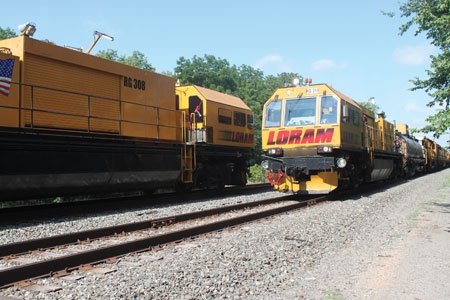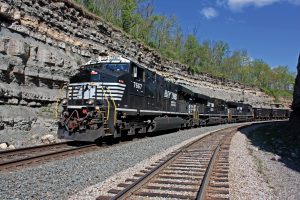Grinding out the ideal rail profile
Written by Mischa Wanek-Libman, editor
The role grinding practices hold in rail profile management calls for special care with one of the railroads' most expensive assets.
{besps}June14_grinding{/besps} {besps_c}0|1grinding.jpg|A Harsco Rail unit.{/besps_c} {besps_c}0|2grinding.jpg| A Loram Maintenance of Way grinder on track.{/besps_c} {besps_c}0|3grinding.jpg| A rendering of Vossloh Rail Services’ High Speed Grinding city unit. The company says the unit is designed for use within the tight spaces found on transit systems.{/besps_c}
The role grinding practices hold in rail profile management calls for special care with one of the railroads’ most expensive assets.
Rail grinding, especially on a large scale, requires a delicate balance to acheive the desired rail profile while not removing too much metal and not taking too much track time, all in the name of asset life extension. But, to paraphrase one response to our questions, it doesn’t matter how fast the grinding speed, how much metal is removed or how high-quality the lubricant is, if the railroads do not have the manpower and finances to keep up with the rail degradation rate.
Harsco Rail
Harsco Rail recently launched its advanced Accelerometer Based Corrugation System and applied it to they company’s transit grinders where it utilizes high-response accelerometers mounted to the axle box of the car, based at the wheel/rail interface. The company says it is also progressing into the next evolution of its SmartGrind technology, which ties into the Jupiter Control System of its grinding machine.
“The SmartGrind technology is a real-time profile grinding analysis and quality control system utilized by grinders and track geometry cars. Ultimately, this will give an advanced control of the grinding process. The system provides railway personnel with grinding requirements and content grinding production; the SmartGrind system has been successfully updated on our production grinders,” said Harsco.
The company is currently manufacturing a European 30-stone transit grinder that features both the Accelerometer Based Corrugation and SmartGrind Systems and is scheduled for delivery this year.To ensure accuracy of its grind, Harsco measures the rail profile and rail corrugation before, during and after grinding.
“These key performance indicators are monitored and grinding pattern suggestions are made to the operator to efficiently remove metal (i.e. minimize) until these parameters are within acceptable limits. Thus, the final profile will match the desired profile (to control the wheel/rail interface) and corrugation (and other surface deformation, such as Rolling Contact Fatigue) will be removed, leaving an acceptable rail surface finish behind,” said Harsco.
The company believes the evolution of grinding technology will continue to strive to provide improved asset life extension, while requiring a minimal amount of on track time.
“The balance is to remove the proper amount of metal at the highest possible grinding speed and the minimum number of passes. The key is to remove only that amount of metal required to remove surface deformation and establish proper running profile, without over grinding,” said Harsco. “Effective control and feedback systems help achieve this. In addition, selecting the proper grinding cycle is equally as important to optimize the extension in rail life. Further development of rail surface inspection techniques (machine vision, eddy current, etc.) will provide more information in the feedback loop. Further developments in these systems are being extended to switch grinding to achieve the same effectiveness we have seen over the years in plain line grinding. Also, the move towards performance-based grinding is becoming more predominant, with the goal of enhancing asset life, not just generating sparks. Harsco continues to work with its customers to provide not only state-of-the-art equipment, but expertise in overall rail maintenance, to achieve this goal.”
Loram
Loram Maintenance of Way, Inc., calls grinding one of its primary core competencies and says the strong demand it sees in the market is driven by the company’s product depth and ability to respond to customer needs.
Darwin Isdahl, vice president, Asset Management Services, says Loram’s 400 Series Grinder, is a highly productive, revolutionary machine developed with the latest technology and offers value beyond compare, which has been one of the company’s most successful products.
Isdahl says Loram’s RGS Series is ideal for specialty grinding needs, allowing customers to optimize productivity, reduce cost and increase asset life of switches and crossing rail; while customers needing a solution for restrictive clearance and axle weight should look to the Loram RGI Series and C21/C31 Series and customers looking for a “truckable” option will find its in the L–Series Grinder.
While equipment is one part of the grinding equation, Isdahl says a good pre-inspection is where accurate grinding begins.
“Rail profiles are measured in a rail inspection vehicle, comparing them to a pre-determined optimal template. The profiling needs are combined with a depth of cut as a result of an assessment of surface condition to develop a grind plan, including speeds, grind motor locations and number of passes required. This information is then fed into the rail grinder. The grinding itself is computer-controlled and regularly calibrated to ensure accuracy. The horsepower of the grind motors adjusts as the machine speed varies due to restricted speed conditions to maintain a consistent metal removal rate. The large grinders all feature an onboard profile measurement system to check compliance to the optimal profile, along with a dual encoder/GPS location system that automatically selects the proper template for the track location. The grind and profile data is stored and available for future reference,” said Isdahl.
He continued by pointing out that the process is refined by continuing to study the deterioration of rail and causes for variation and then incorporating those findings into the decision-making process.
“Numerous test sites are evaluated along with vast amounts of data collected from every Class 1 railway in North America. Refinements in the grind plan development process continue to improve the ability to achieve the profiling and metal removal objectives at the maximum efficiency.”
“As traffic density continues to increase, it is critical to get the work done as efficiently as possible. We foresee continued movement toward precision in achieving the desired profile and removing the fatigued metal, all while removing as little metal as is required at the fastest speeds possible. This process leaves more of the rail head and extends the life of the rail while grinding at faster speeds, fewer passes and spending less time,” said Isdahl.
Vossloh Rail Services
“We like to think of typical ‘rail grinding’ as the process of overall ‘Rail Profile Management.’ This term helps cover the various technologies being used in rail maintenance throughout the world,” said Ron Martin, vice president and general manager of Vossloh Rail Services.
One of the company’s technologies that has experienced acceptance on the world stage is its rail milling system, which Vossloh Rail Services has committed to bring to the U.S. market.
“The milling system is a truck-mounted unit that will help those considering the technology, the chance to use it and understand the applications and quality of work it can accomplish,” said Martin. “This is an exciting time in that the rail milling is being considered by many roads and transits but without the opportunity to apply it to each of their problem areas, it has been difficult to show the technology will perform as advertised.”
The company is also finishing the validation on its High Speed Grinding (HSG) city unit, designed for use in the tighter confines of transit applications. Martin says the city unit offers 100 percent spark suppression, as well as a very clean rail and rail contact fatigue mitigation in the maintenance mode instead of waiting for extreme rail degradation when corrective grinding is required. Vossloh Rail Services says the city unit is capable of grinding the top layer of rail off at speeds up to 35 mph.
To ensure accuracy, the HSG systems will match the existing profile so validation is done prior to the units work. According to Martin, there can be minor gauge corner corrections made on the fly so any pre-inspections will allow that information to be passed onto the crews.
Vossloh utilizes eddy current testing as the secondary method of validation for its rail milling, which allows the testing group to see if there is any rolling contact fatigue remaining after the milling has taken place. Martin says the eddy current testing will look at the first three millimeters of the rail from the head to identify those cracks that have started, but aren’t big enough to be identified with the ultra-sonic testing, thus, ensuring all the defects are removed, not just the largest defects.
“Rail profile management will continue to evolve as varying methods contributing to the overall rail life-cycle extension are considered and used. The speeds might get higher, the metal removal rates may increase and the lubricant may get better, but even if all these contributing factors evolve, the railroad still has to have the manpower and finances to keep up with the degradation rate of the rail,” said Martin.”As we’ve seen in the past few years, many roads are getting further along the curve to that of maintenance, but there is still so much corrective work to be done and with traffic increasing, it may take many more years to get to a point where the rail salvage rate will be higher than the rail replacement rate.”





